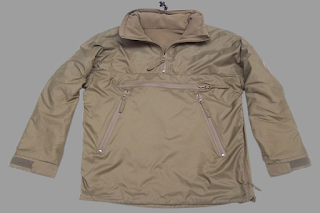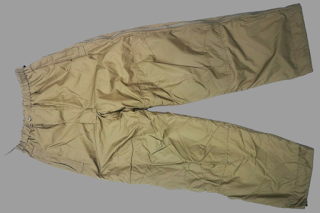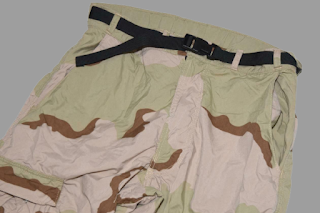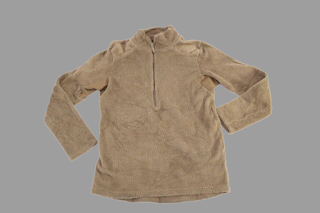...
2011
The PCS consists of Combat uniform, Ancillary items and Waterproof clothing.
..

About
All camouflage items will be in Multi-Terrain Pattern (MTP) and other items will be in Khaki.
Anything Else
 We are, of course, interested in any other item that fits the collection, even if it is not listed here. If you have additional information, or if you have surplus equipment that you want to share, please contact us.
We are, of course, interested in any other item that fits the collection, even if it is not listed here. If you have additional information, or if you have surplus equipment that you want to share, please contact us.SELECTED ARTWORKS IN THE COLLECTION
....





History
The original programme to replace CS95 was called Personal Equipment and Common Operational Clothing (PECOC) and this has now evolved into Personal Clothing System (PCS)
PECOC had a wide scope, clothing, personal equipment, load carriage and protection. Instead of maintaining a monolithic programme the MoD decided to spin out the clothing elements, under PCS and the load carriage and protection elements under Project VERTUS.
PECOC had a wide scope, clothing, personal equipment, load carriage and protection. Instead of maintaining a monolithic programme the MoD decided to spin out the clothing elements, under PCS and the load carriage and protection elements under Project VERTUS.
xxx
The design principles of CS95 as a layered system of clothing allowing flexibility for temperature regulation remain extant. This has been retained in the PCS; however, it recognises the increased requirements for protection, both in the integration with body armour and incorporation of extremity protection and fittings for potential combat identification systems.
Components
The PCS consists of three distinct elements that will be delivered separately.
The MTP Camouflage Outer Layers consist of:
Lightweight Jacket. A shirt that can be worn over a thermal or sweat-wicking layer. It can be worn either tucked into trousers or loose depending on environmental conditions.In order to allow body armour to be worn over the top (in temperate conditions) buttons have been removed and replaced with Velcro and a zip. Chest bellows pockets have been replaced with map pockets with pen and notebook/compass stowage.Bicep bellows pockets have been added to arms to allow stowage of ready access items when body armour is worn. In addition, pockets have been added to the outside forearms and elbows to allow for additional fragmentation/bump protection to be fitted if required.The collar can be secured up when wearing body armour to reduce chafing. The bicep pockets have ‘touch and close’ panels to allow combat ID badges to be fitted if required.A blanking plate protects the touch and close fastening while also allowing non-tactical badges (eg tactical recognition flashes) to be fitted while being removable in the field.
Combat trousers. Thigh map pockets have been angled to allow easier access. A secure pocket has been added to waist pockets to allow stowage of small items. The draw cord has been removed. A seat panel has been added to reduce wear in the crotch. Map-pocket buttons have been shrouded to reduce snag hazards.
Windproof smock. The design of the existing windproof smock has been retained as an outer garment principally for when body armour is not being worn. A mesh drop liner and armpit vents have been added to help with thermal regulation.Buttons have been shrouded to reduce snag hazards. Behind the waist pockets, fleece-lined handwarmer pockets have been added. The windproof smock incorporates the same bicep pockets as the lightweight jacket.
Rank slides. No change to the current design. Only low-contrast, all-arms rank slides are to be worn on MTP. Regimental/high contrast rank slides for wear in camp are to be on plain/regimental backgrounds.
Helmet covers. No change to the existing range of helmet cover design, although an update is in development.
Combat trousers. Thigh map pockets have been angled to allow easier access. A secure pocket has been added to waist pockets to allow stowage of small items. The draw cord has been removed. A seat panel has been added to reduce wear in the crotch. Map-pocket buttons have been shrouded to reduce snag hazards.
Windproof smock. The design of the existing windproof smock has been retained as an outer garment principally for when body armour is not being worn. A mesh drop liner and armpit vents have been added to help with thermal regulation.Buttons have been shrouded to reduce snag hazards. Behind the waist pockets, fleece-lined handwarmer pockets have been added. The windproof smock incorporates the same bicep pockets as the lightweight jacket.
Rank slides. No change to the current design. Only low-contrast, all-arms rank slides are to be worn on MTP. Regimental/high contrast rank slides for wear in camp are to be on plain/regimental backgrounds.
Helmet covers. No change to the existing range of helmet cover design, although an update is in development.
Ancillary items will include insulation and sweat-wicking layers, consisting of:
T-shirt. Base layer, providing both thermal insulation and sweat-wicking. Based upon the current operational hot-weather t-shirt.
Underwear. Sweat-wicking, anti-microbial unisex undershorts based upon the existing operational underwear.
Thermal shirt. A micro-fleece base layer shirt with zippered collar (replacing the CS95 Norwegian shirt).
Thermal smock. A micro-fleece-lined mid-layer, with windproof and showerproof outer, to provide increased insulation under the windproof smock (replaces the CS95 fleece).
Under Body Armour Combat Shirt (UBACS). A sweat-wicking torso with lightweight jacket sleeves and a zippered neck for wear under body armour in hot weather environments.
T-shirt. Base layer, providing both thermal insulation and sweat-wicking. Based upon the current operational hot-weather t-shirt.
Underwear. Sweat-wicking, anti-microbial unisex undershorts based upon the existing operational underwear.
Thermal shirt. A micro-fleece base layer shirt with zippered collar (replacing the CS95 Norwegian shirt).
Thermal smock. A micro-fleece-lined mid-layer, with windproof and showerproof outer, to provide increased insulation under the windproof smock (replaces the CS95 fleece).
Under Body Armour Combat Shirt (UBACS). A sweat-wicking torso with lightweight jacket sleeves and a zippered neck for wear under body armour in hot weather environments.
Waterproof Clothing
Jacket Combat MVP MTP
Various different designs of waterproof garments are currently being assessed as part of the ongoing development of the PCS with an expected fielding date of 2012. All items will be in MTP. A review of the need for specific female designs is underway and results will be trialled accordingly. These will be rolled out separately once designs have been finalised..









No comments:
Post a Comment